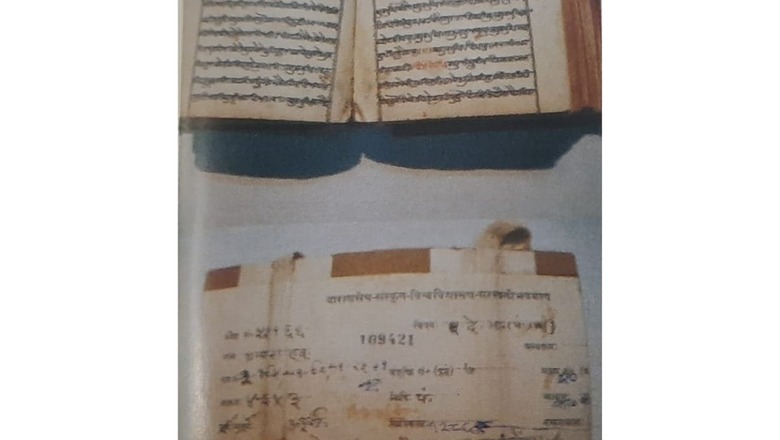
views
As someone who has been interested in understanding the Sanskrit language, I was very excited to get my hands on Paramu Kurumathur’s new book, 108 Facts About Sanskrit You Didn’t Know. I am glad to tell you that I was not disappointed.
There is a great revival of interest in the Sanskrit language. In India, this revival is due to the realisation that India’s ancient heritage has come down to us through the medium of Sanskrit; that almost all our languages owe their being — either directly or indirectly — to Sanskrit; that there is a tremendous amount of literature available in Sanskrit for us to enjoy; and finally, that we need a language other than English that we can call our own and take pride in. Outside India, this revival is due to the realisation that Sanskrit — as the earliest of the classical languages — has contributed immensely not only to the other classical languages but also to the current languages; so, a study of these languages and the civilisations in the world will not be complete without a good understanding of Sanskrit.
My interest was to get an overall idea of what the Sanskrit language is: specifically, how ancient the language is, what its contributions to the world are, what the origins of the language are and how it is related to the other languages of the world, how it evolved into the currently spoken Indian languages but still continued to be India’s lingua franca, the great amount of literature available in the language, an idea about the structure of the language, Sanskrit during the Vedic period, and how we, in the modern era, can reclaim the language for ourselves.
One surely must not have seen any handy book that gives readers a simple but broad introduction to the language, covering all the aspects above. Kurumathur’s book clearly addresses this concern. This book is an attempt to bring to readers the great treasure that is Sanskrit. It is a comprehensive guide to the language that is easy to follow and incredibly informative. One more appreciable thing about this book is that it does not assume any prior knowledge of Sanskrit. Even as someone who has been trying to dabble in the language for a while, one finds oneself learning new things.
The book is well organised. It is laid out in nine sections, with each section addressing one aspect of the language. Facts about the language are presented in 108 facts, spread across these nine sections. Kurumathur’s writing style is engaging and easy to follow, making it a pleasure to read and learn from. The nine sections look at the following aspects of Sanskrit: Its history, the basics of Sanskrit, the greatness of the language, euphonies in Sanskrit, its structure, syntax, Sanskrit during the Vedic Period, appreciation and analysis, and reclaiming Sanskrit.
The way the book starts is exuberant. Kurumathur establishes that Sanskrit is at least 6,000 years old by citing internal evidence and evidence of the lack of writing during the period. He also establishes that there is a continuous tradition of Sanskrit from Vedic times to today. He traces the evolution of the language from the Vedas to the Brāhmaṇas and the Upanishads, then to the various Sutras, and finally to the Code of Manu, which represents the start of the classical period of the language. He also traces how Vedic Sanskrit evolved into some of the languages of today. Through this, he establishes that Sanskrit is the bearer of Indian culture.
The global role of the language is also discussed in the book. It looks at the concept of language families and discusses the close connection between Sanskrit, Avestan, Greek, Latin, and other Indian and European languages. These ideas are brought out very clearly by Kurumathur. There is a detailed discussion on the great quantity and quality of the literature available in Sanskrit from ancient times to now and that there was a great tradition of Sanskrit-based teaching and learning in India (by all sections of society) till the British came and deliberately neglected and then uprooted this system to introduce Western education systems.
The book looks at the literature of the Vedic and classical periods of the language. It discusses the Vedas, the Brāhmaṇas, the Āraṇyakas and the Upanishads; the various Sutras. It was particularly of great interest to me to know that the Śulva Sutras are some of the earliest works on mathematics and show an advanced knowledge of geometry (including the earliest form of the Pythagoras theorem), trigonometry, and algebra. The contributions of the great grammarian Pāṇini and the etymologist Yāska are examined in detail in this section. The book then moves on to the epics and the purāṇas. After that, it moves on to the secular literature in Sanskrit, including those by the great Kalidasa.
Then it discusses historical writings, fairy tales, philosophical works and law books, thesauri, astronomy and mathematical books, books on medicine, the arts, eroticism, logic, and tantrism. It also talks of panegyrics, works on sculpture and painting, and music. The next sections go into detailed discussions on the structure of the language and its syntax and semantics. For people interested in the Vedas, there is a full section that discusses the Sanskrit of the Vedas and brings out the differences between Vedic and Classical Sanskrit. I particularly liked the discussions about the accents of Vedic Sanskrit.
One section of the book looks at how we can appreciate the language and literature and how we can analyse Sanskrit writings and texts. There is an interesting “fact” about semantic analysis. There is also a discussion on constrained writing. There are a couple of facts that look at how we can have fun with the language by looking at riddles and a crossword.
The last section looks at how we can establish Sanskrit as the national language of India. It also discusses the need for re-interpreting Sanskrit works, as proposed by Aurobindo, so that we get the actual meaning of the writings rather than go with the biased interpretations of the Western Sanskritists and later, Indians, who followed the lead of the Westerners.
Kurumathur takes a couple of Vedic hymns from the Vedas and interprets them as history to prove that the Vedas contain more than just ritualistic formulae. If I must nitpick, I would say that Kurumathur could have included some more details about astronomical, mathematical, and scientific writings in Sanskrit. Also, I felt that the “fact” on mindfulness did not fit into the context of the book.
In toto, I would highly recommend Paramu Kurumathur’s book 108 Facts About Sanskrit You Didn’t Know to anyone looking to have a broad introduction to the language. Whether you are a beginner or an advanced student of Sanskrit, this book has something to offer to all.
Yuvraj Pokharna is an independent journalist and columnist. He tweets with @iyuvrajpokharna. Views expressed are personal.

















Comments
0 comment